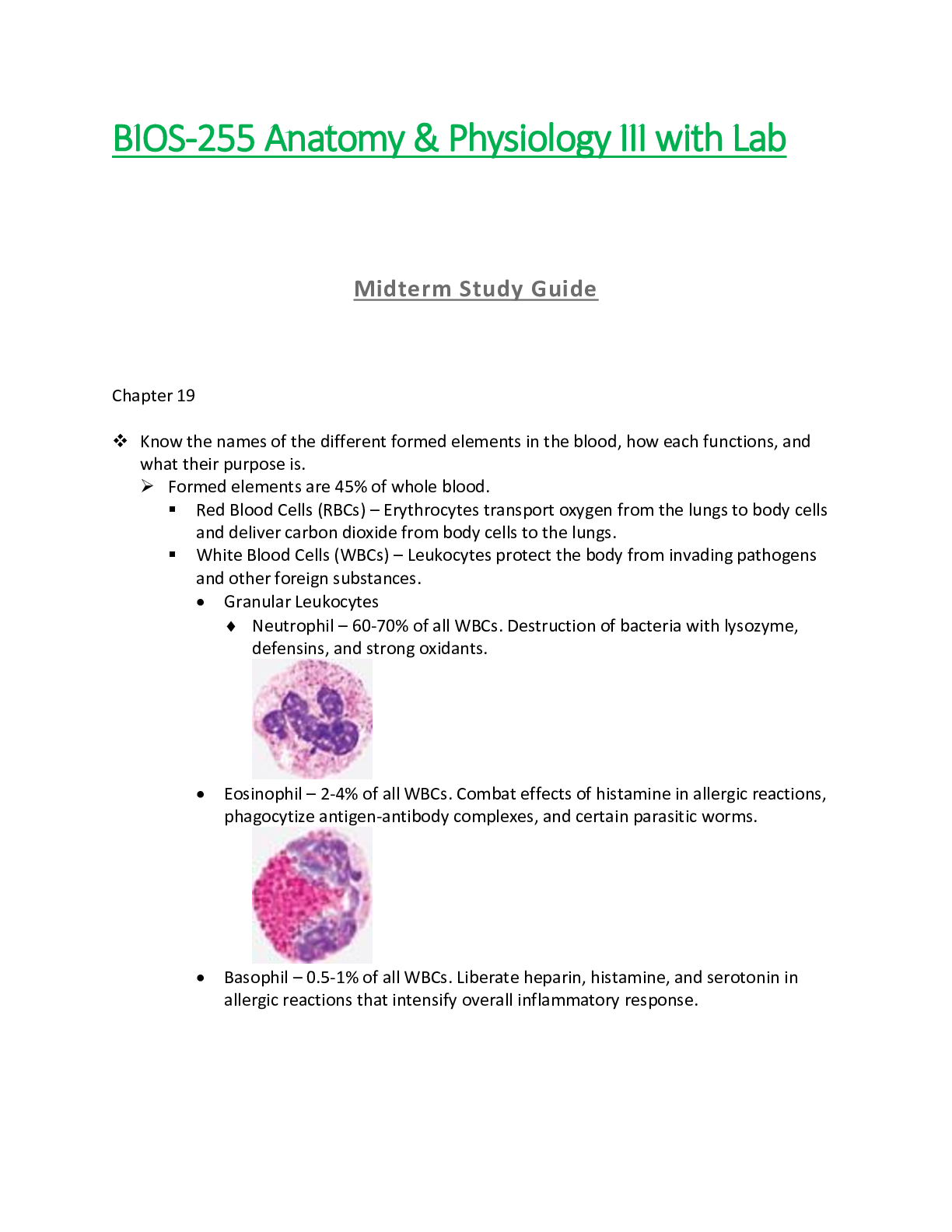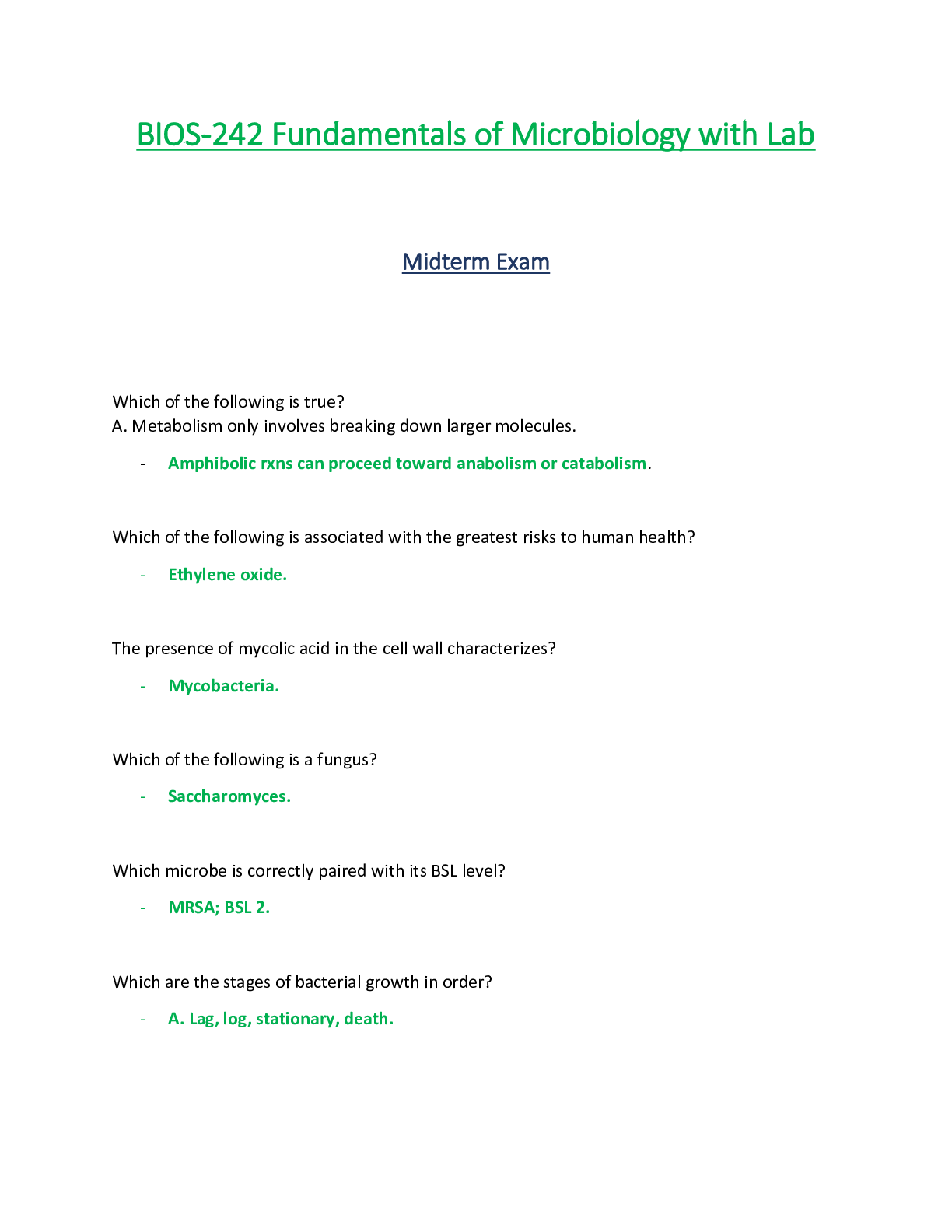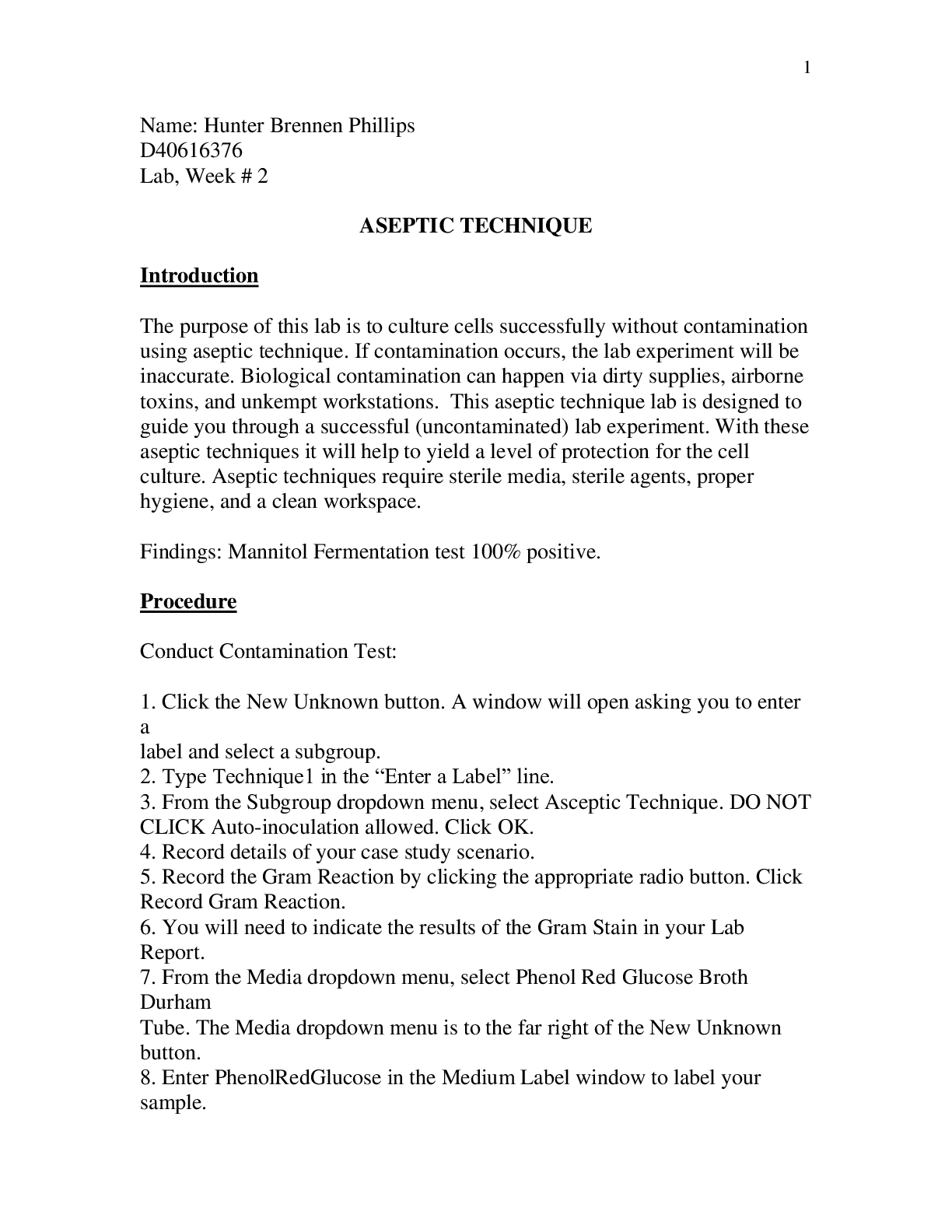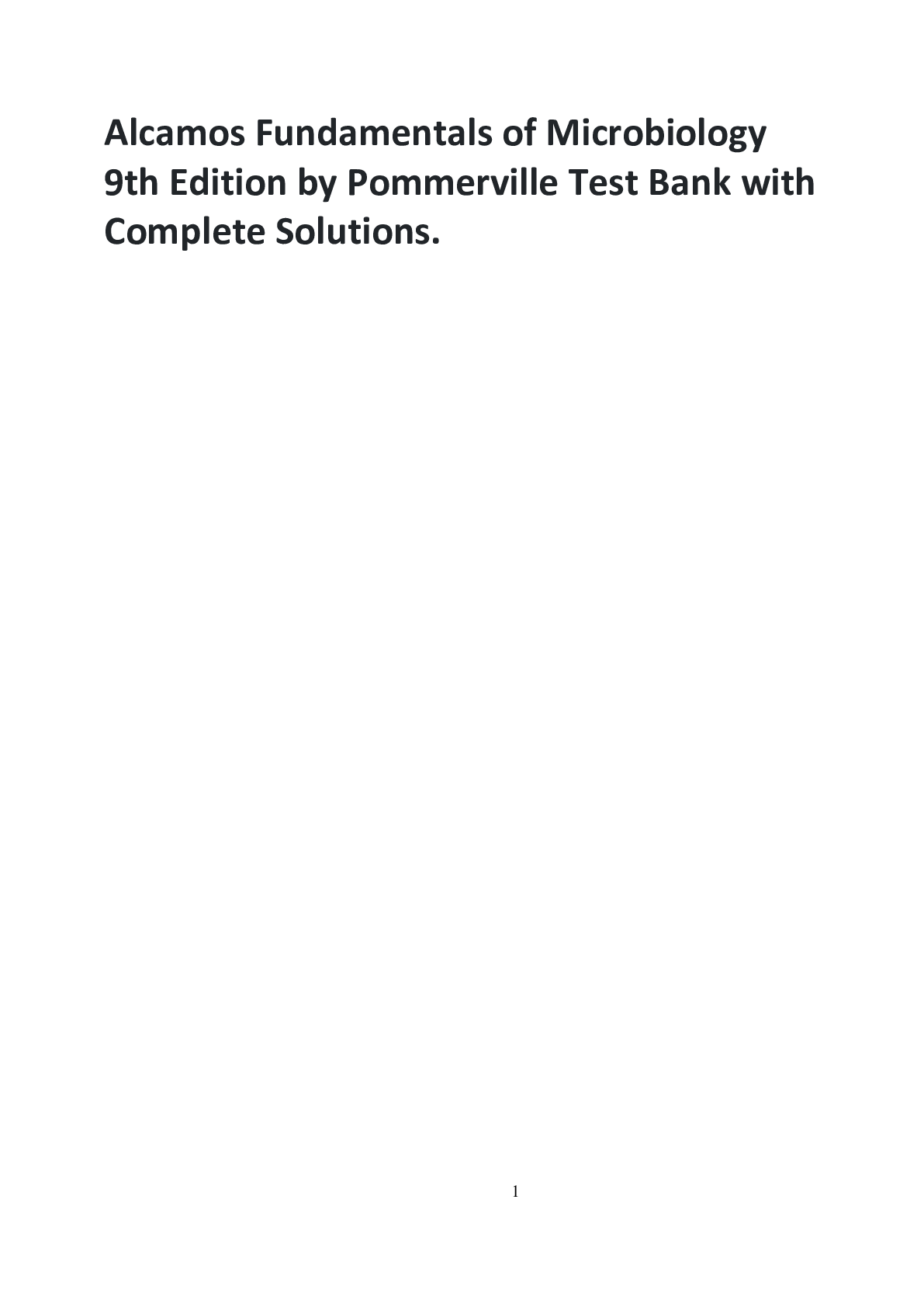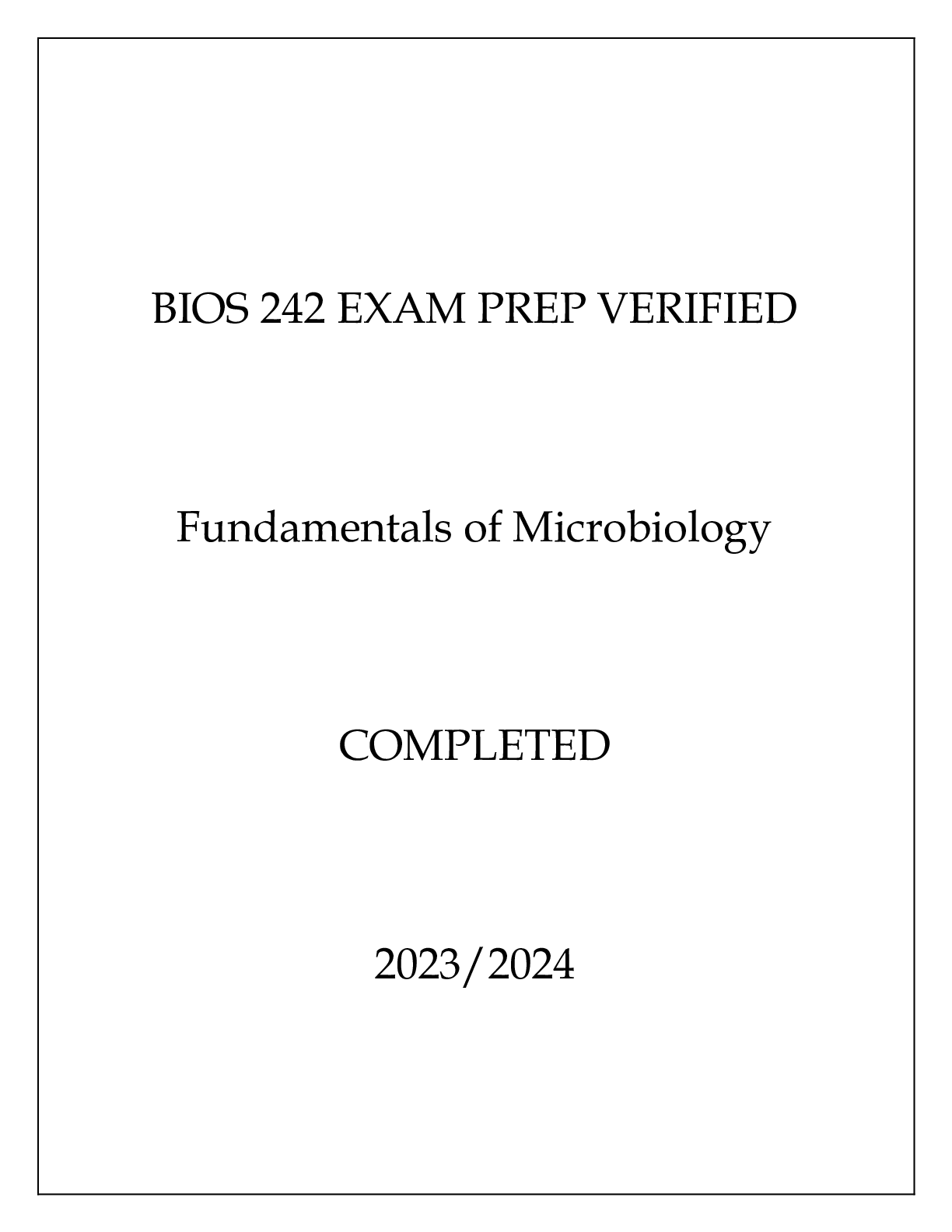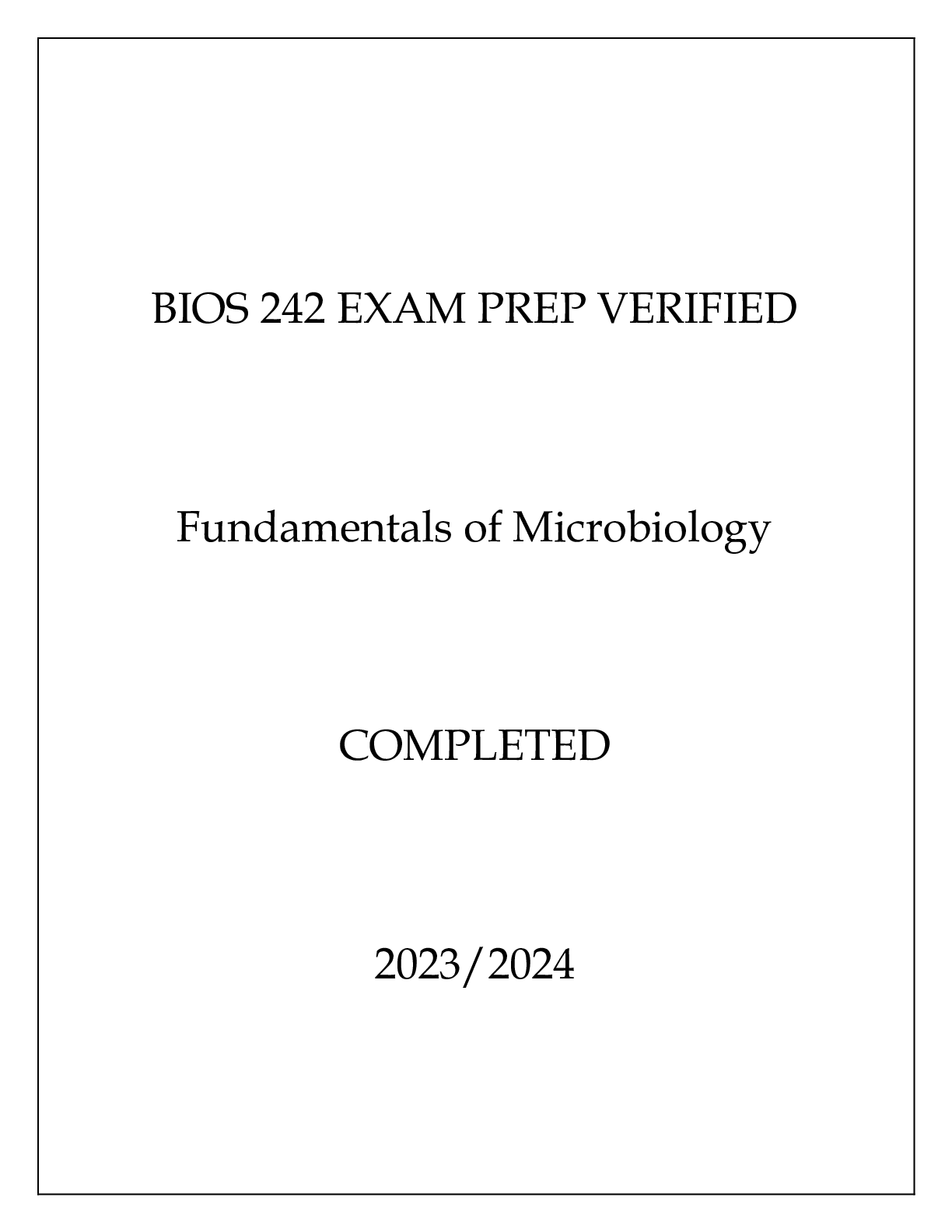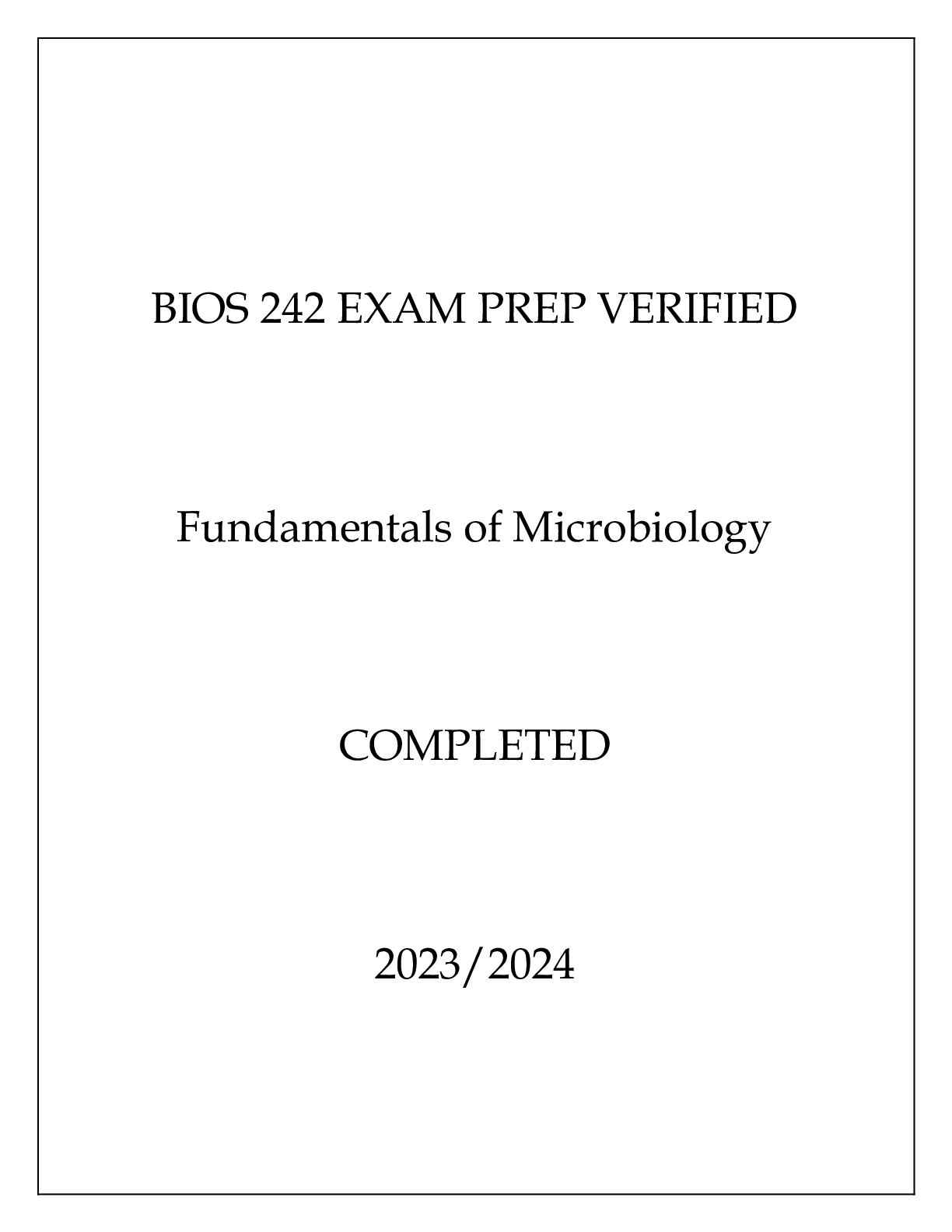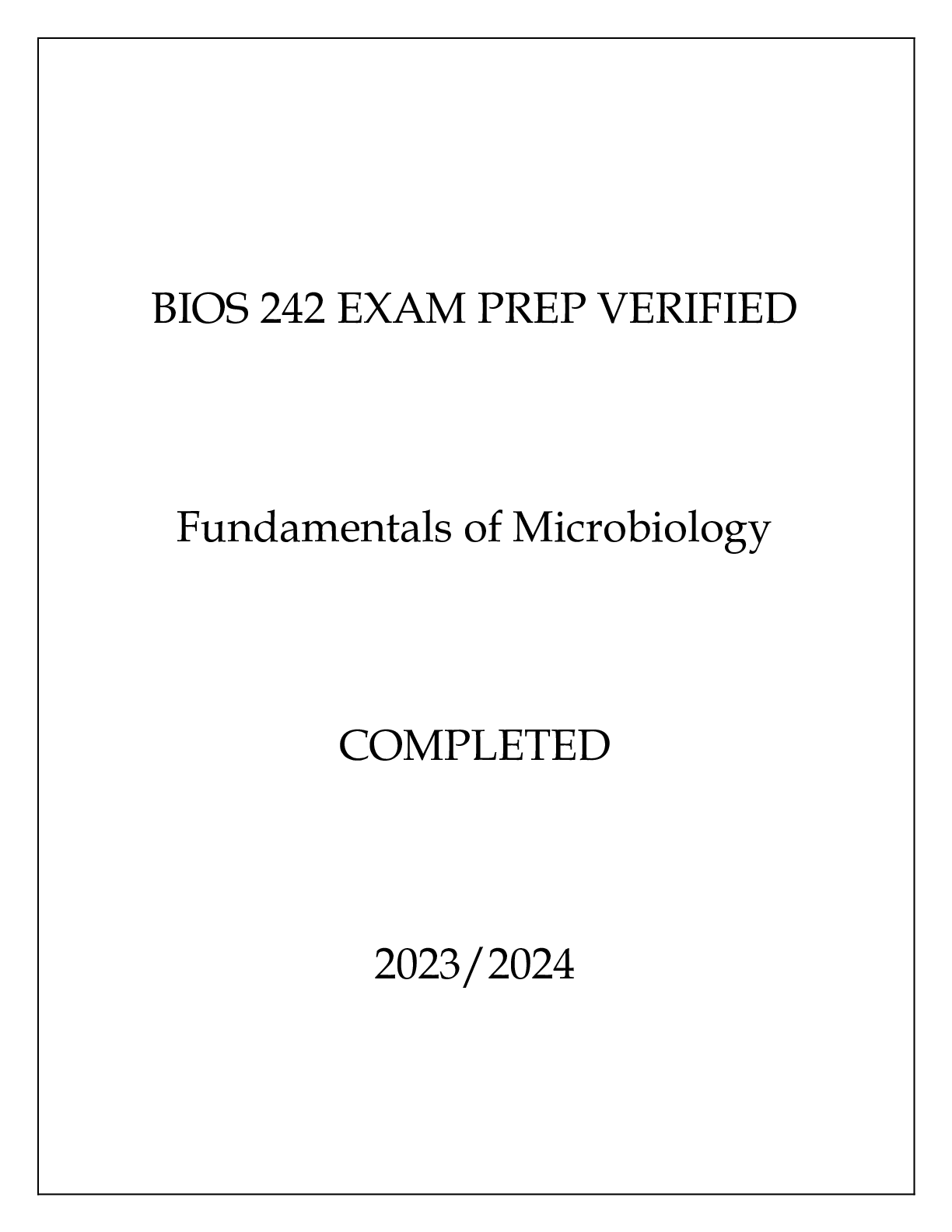Micro Biology > EXAM > BIOS 242 Fundamentals of Microbiology with Lab Midterm Exam 1 (2021/2022) Answered Retake all correc (All)
BIOS 242 Fundamentals of Microbiology with Lab Midterm Exam 1 (2021/2022) Answered Retake all correct answers.
Document Content and Description Below
BIOS 242 Fundamentals of Microbiology with Lab Midterm Exam 1 1. Question : Antoni van Leeuwenhoek was the first person in history to Student Answer: use a magnifying glass. develop a taxonomi... c system. view protozoa and bacteria. disprove spontaneous generation. prove the germ theory. Question 2 . Question : Microbes that can live in the presence or absence of oxygen are called Student Answer: anaerobes. facultative anaerobes. obligate parasites. archaea. prokaryotes. Question 3 . Question : Which of the following scientists provided evidence in favor of the concept of spontaneous generation? Student Answer: Pasteur Needham Redi Buchner Spallanzani Question 4 . Question : The microbial production of alcohol from sugar is known as Student Answer: fermentation. pasteurization. metabolism. abiogenesis. antisepsis. Question 5 . Question : Which of the following statements concerning Koch's postulates is false? Student Answer: Koch's postulates cannot be used to demonstrate the cause of all diseases. A suspected pathogen must be able to be grown in the laboratory. All of Koch's postulates must be satisfied before an organism can be proven to cause a particular disease. Koch's postulates involve the experimental infection of susceptible hosts. A suspected pathogen must be found in the majority of individuals with a particular disease. Question 6 . Question : The study of the body's defenses against pathogens is called Student Answer: etiology. immunology. chemotherapy. molecular biology. epidemiology. Question 7 . Question : Which of the following is NOT a characteristic of viruses? Student Answer: they are visible with a light microscope. they are acellular. they are composed of genetic material and protein. they are smaller than prokaryotic cells. they are obligatory parasites. Question 8 . Question : Saccharomyces cerevisiae is an example of which of the following types of microbes? Student Answer: fungus protozoan prokaryote alga virus Question 9 . Question : Proteins that promote chemical reactions in the cell are called Student Answer: spores. enzymes. genes. protozoa. flagella. Question 10 . Question : Which of the following scientists was the first to develop a taxonomic system for classifying organisms? Student Answer: Linnaeus Needham Leeuwenhoek Lister Pasteur Question 11 . Question : Robert Koch was involved in research on all of the following topics EXCEPT Student Answer: the cause of anthrax. the cause of fermentation. development of a method to prove the cause of an infectious disease. the cause of tuberculosis. techniques for isolating microbes in the laboratory. Question 12 . Question : Microorganisms characterized by the absence of a nucleus are called Student Answer: fungi. pathogens. eukaryotes. prokaryotes. viruses. Question 13 . Question : The term literally means "produces disease." Student Answer: prokaryote pathogen nosocomial facultative anaerobe animalcule Question 14 . Question : The study of the causation of disease is known as Student Answer: epidemiology. immunology. biotechnology. etiology. chemotherapy. Question 15 . Question : The study of the occurrence, distribution, and spread of disease is known as Student Answer: biotechnology. epidemiology. molecular biology. serology. biochemistry. Question 16 . Question : Short, hairlike structures used only by eukaryotic cells for movement are called Student Answer: pili. flagella. fimbriae. pseudopodia. cilia. Question 17 . Question : Which of the following is NOT a component of bacterial cell walls? Student Answer: peptidoglycan lipoteichoic acids mycolic acid tetrapeptide tubulin Question 18 . Question : Endospores survive a variety of harsh conditions in part because of the presence of Student Answer: mycolic acid. lipopolysaccharide. hopanoids. dipicolinic acid. glycoproteins. Question 19 . Question : When cells are placed in a hypertonic solution, they lose water and shrivel. This process is called Student Answer: crenation. endocytosis. passive transport. periplasm. plasmalemma. Question 20 . Question : All of the following are common to both the Gram stain and the acid- fast stain EXCEPT Student Answer: primary stain. counterstain. a decolorizing agent. a mordant. a decolorizing agent and a counterstain. Question 21 . Question : A patient suffering from tuberculosis could be diagnosed by use of the stain. Student Answer: Gram endospore acid-fast flagellar capsule Question 22 . Question : Carbolfuchsin is the in the acid-fast stain. Student Answer: primary stain mordant decolorizer counterstain fixing reagent Question 23 . Question : The kingdoms included in the Linnaeus system are Student Answer: Animalia and Prokaryotae. Protista and Plantae. Fungi and Protista. Animalia and Plantae. Prokaryotae and Protista. Question 24 . Question : The rules of naming organisms are called Student Answer: taxonomy. nomenclature. classification. binomials. identification. Question 25 . Question : In the Gram stain procedure, iodine serves as a Student Answer: counterstain. decolorizing agent. mordant. primary stain. fixative. Question 26 . Question : Crystal violet is the in the Gram stain. Student Answer: counterstain decolorizing agent mordant neutralizing agent primary stain Question 27 . Question : The makes use of malachite green. Student Answer: negative stain flagellar stain endospore stain electron microscopy stain acid-fast stain Question 28 . Question : The molecule that an enzyme acts upon is known as its Student Answer: substrate. coenzyme. apoenzyme. holoenzyme. catalyst. Question 29 . Question : Pyruvic acid is a product of Student Answer: the Krebs cycle. fermentation. glycolysis. the Entner-Doudoroff pathway. both glycolysis and the Entner-Doudoroff pathway. Question 30 . Question : In microbiology, the term growth usually refers to an increase in Student Answer: a microbe's size. the number of microbial cells. the amount of ATP produced. the number and size of microbial cells. the number and size of microbial cells and the amount of ATP produced. Question 31 . Question : Human pathogens are classified as Student Answer: thermoduric. thermophiles. mesophiles. hyperthermophiles. psychrophiles. Question 32 . Question : Organisms that can grow with or without oxygen present are Student Answer: obligate aerobes. facultative anaerobes. aerotolerant anaerobes. obligate anaerobes. either facultative anaerobes or aerotolerant anaerobes. Question 33 . Question : Another term for the logarithmic growth of bacterial cells is Student Answer: generation time. exponential growth. arithmetic growth. absorbance. binary fission. Question 34 . Question : During the of growth, cells are dying faster than new cells are being produced. Student Answer: death phase lag phase log phase stationary phase longitudinal phase Question 35 . Question : Metabolic activity is at maximum level in the of growth. Student Answer: lag phase log phase death phase stationary phase intermediate phase Question 36 . Question : Cells are rapidly growing and dividing during the of growth. Student Answer: death phase lag phase log phase stationary phase indeterminate phase Question 37 . Question : Microaerophiles are microbes that grow best at low Student Answer: carbon dioxide levels. pH values. hydrostatic pressure. oxygen levels. salt concentrations. Question 38 . Question : An acidophile thrives under conditions of low Student Answer: carbon dioxide levels. salt concentrations. oxygen levels. hydrostatic pressure. pH. Question 39 . Question : The bacterial chromosome is Student Answer: usually circular. found in a nucleoid. found in a nucleus. both circular and found in a nucleoid. both circular and found in a nucleus. Question 40 . Question : Which of the following is an example of sanitization? Student Answer: A public toilet is treated with disinfectants. A surgeon washes her hands before surgery. Heat is used to kill potential pathogens in apple juice. An autoclave is used to prepare nutrient agar. A nurse prepares an injection site with an alcohol swab. Question 41 . Question : Aseptic means Student Answer: sterile. free of all microbes. clean. sanitized. free of pathogens. Question 42 . Question : Which of the following is a sterilizing agent? Student Answer: ozone hydrogen peroxide peracetic acid dish soap ozone and hydrogen peroxide Question 43 . Question : The process of filtration is a(n) Student Answer: disinfectant method. sterilizing method. sanitization method. antiseptic procedure. ineffective method for removing microbes. Question 44 . Question : Which of the following is NOT a characteristic of a genus name? Student Answer: it is usually an adjective. it is written before the specific epithet. it is always capitalized. it is either underlined or in italics. it is one of two names used to identify an organism. Question 45 . Question : Acidic dyes Student Answer: work best in low pH environments. are negatively charged. are used for staining negatively charged molecular structures. are lipid soluble. are negatively charged and work best at low pH. Question 46 . Question : All of the following are associated with smear preparation EXCEPT Student Answer: agglutination of the specimen. spreading the specimen onto a slide. fixation using heat. killing the microbes in the specimen. fixation using methanol or formalin. Question 47 . Question : The Gram stain works because of differences in the of bacteria. Student Answer: genetic characteristics cell walls cell membranes antigens capsules Question 48 . Question : The metabolic processes called fermentation Student Answer: produce substrates for the Krebs cycle. are alternatives for the pentose phosphate pathway. use an organic molecule as a final electron acceptor. occur only when oxygen is readily available. produce substrates for glycolysis. Question 49 . Question : Which of the following is an incorrect pairing? Student Answer: protozoa: multicellular fungi: cell walls algae: aquatic and marine habitats prokaryotes: no nuclei viruses: acellular parasites Question 50 . Question : Who discovered penicillin? Student Answer: Fleming Ehrlich Kitasato Pasteur Domagk [Show More]
Last updated: 1 year ago
Preview 1 out of 23 pages

Reviews( 0 )
Document information
Connected school, study & course
About the document
Uploaded On
Jul 18, 2021
Number of pages
23
Written in
Additional information
This document has been written for:
Uploaded
Jul 18, 2021
Downloads
0
Views
39

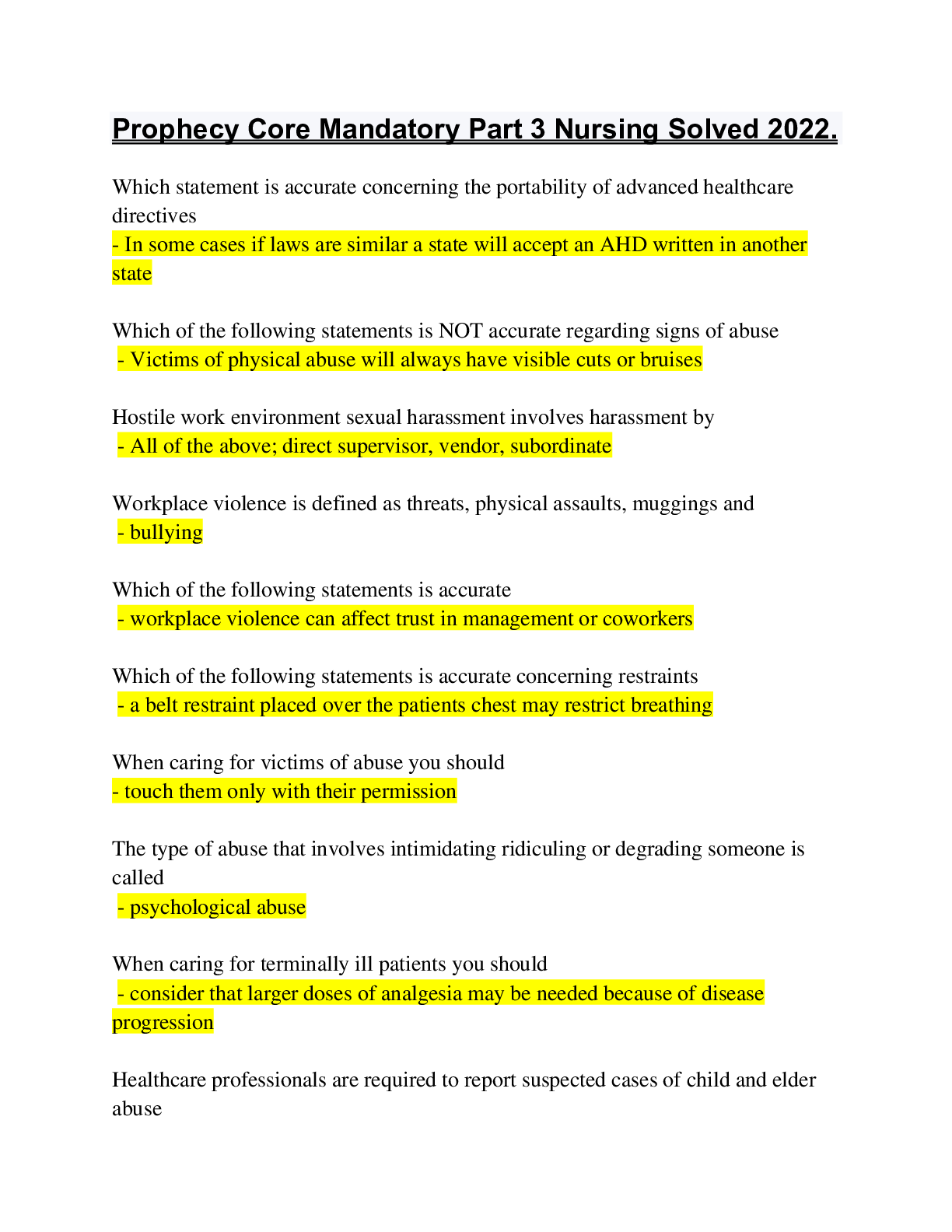
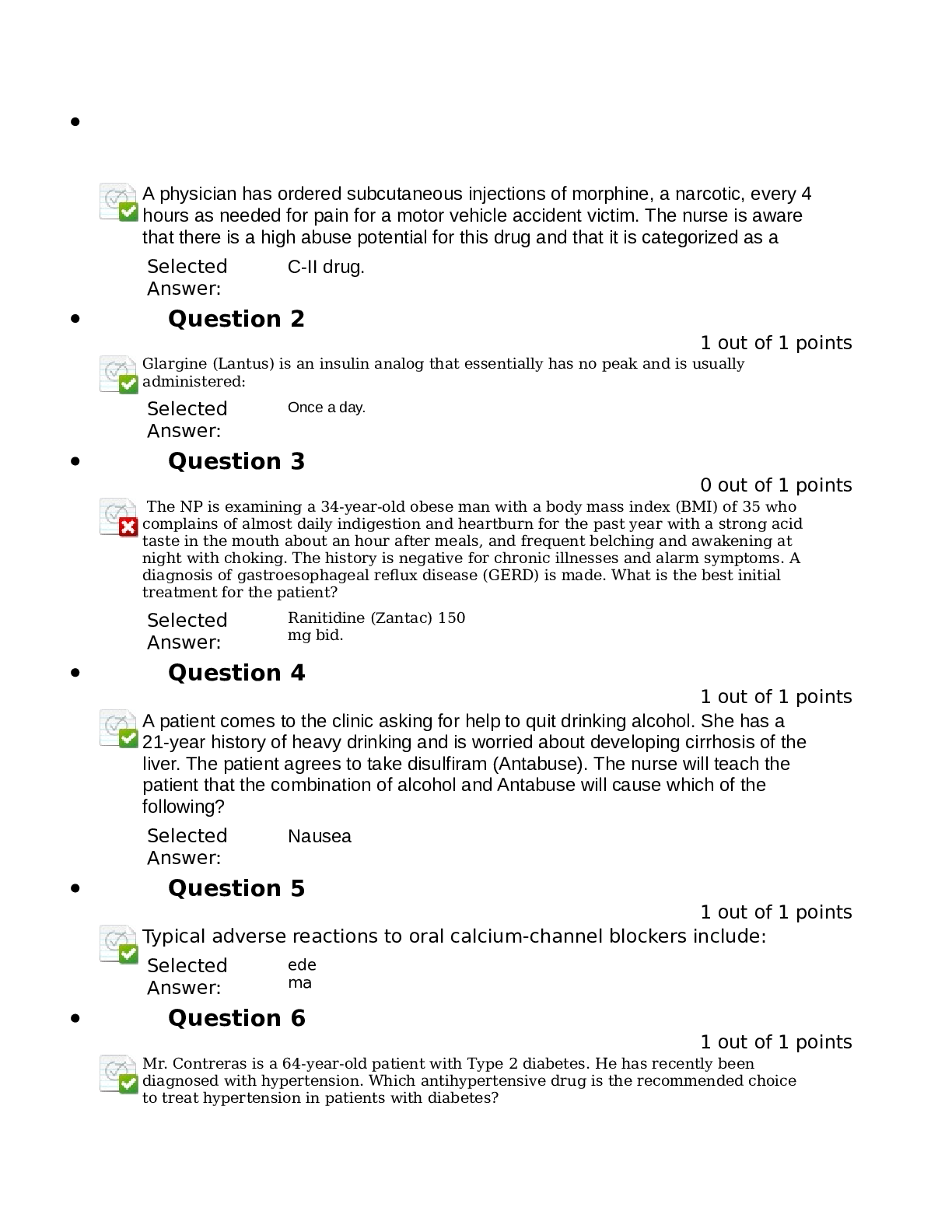
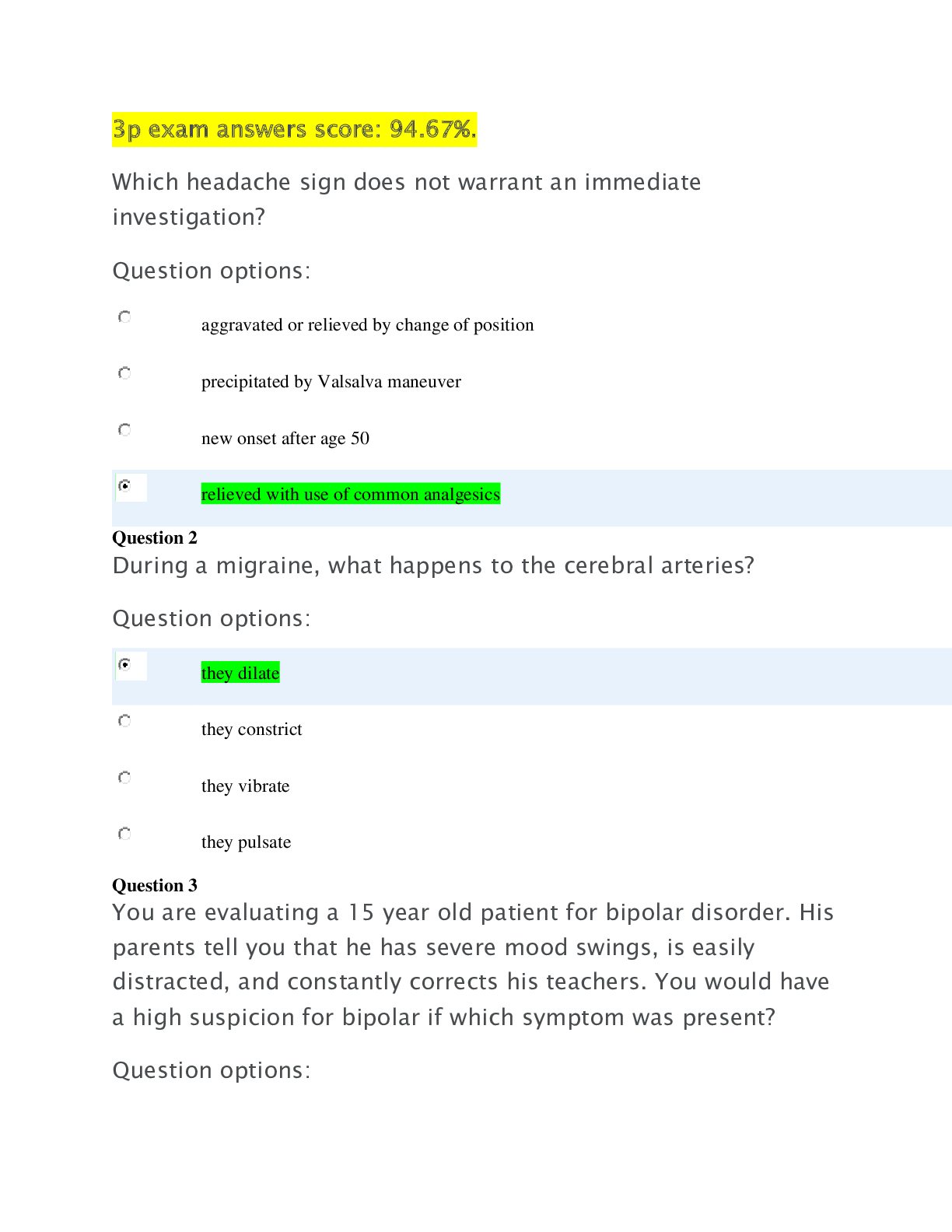
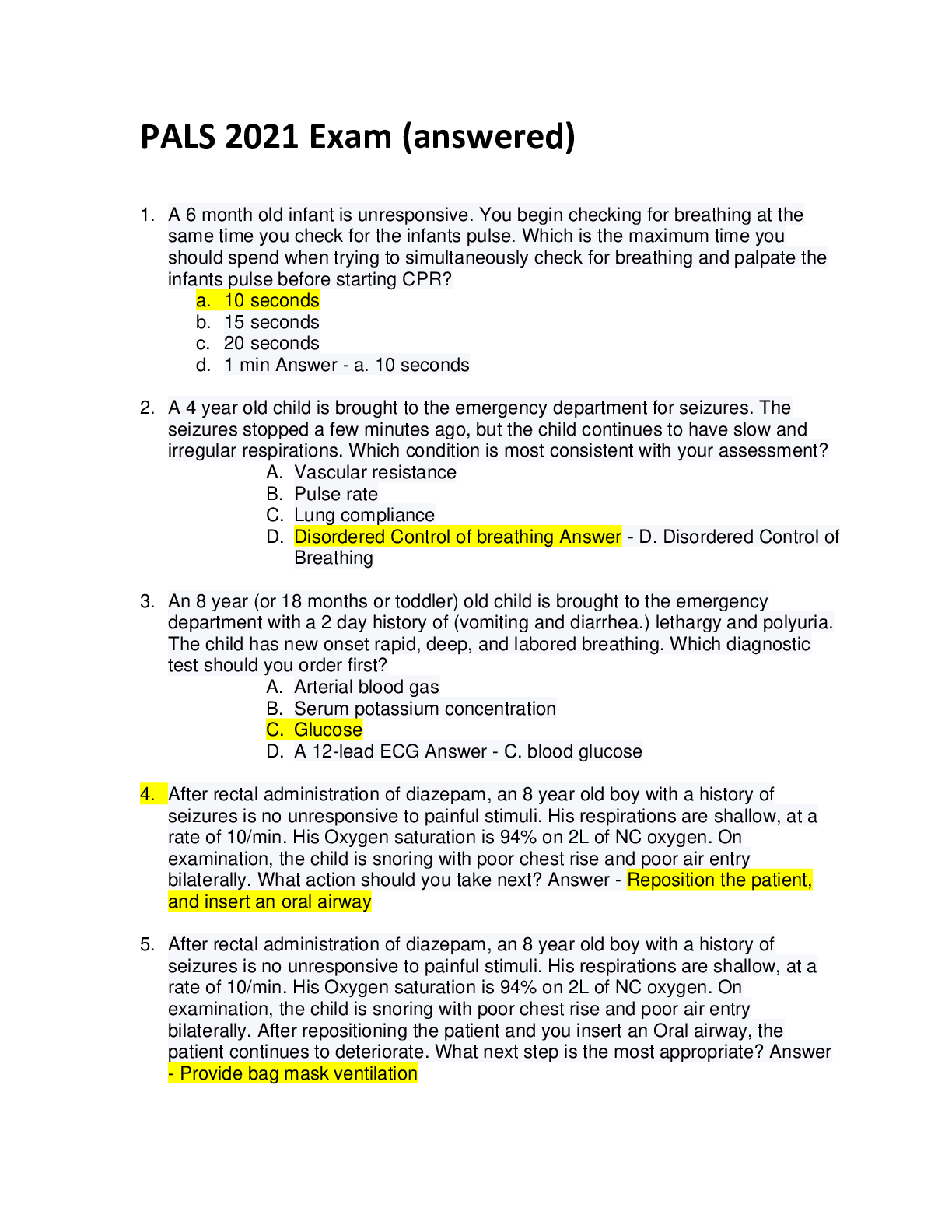
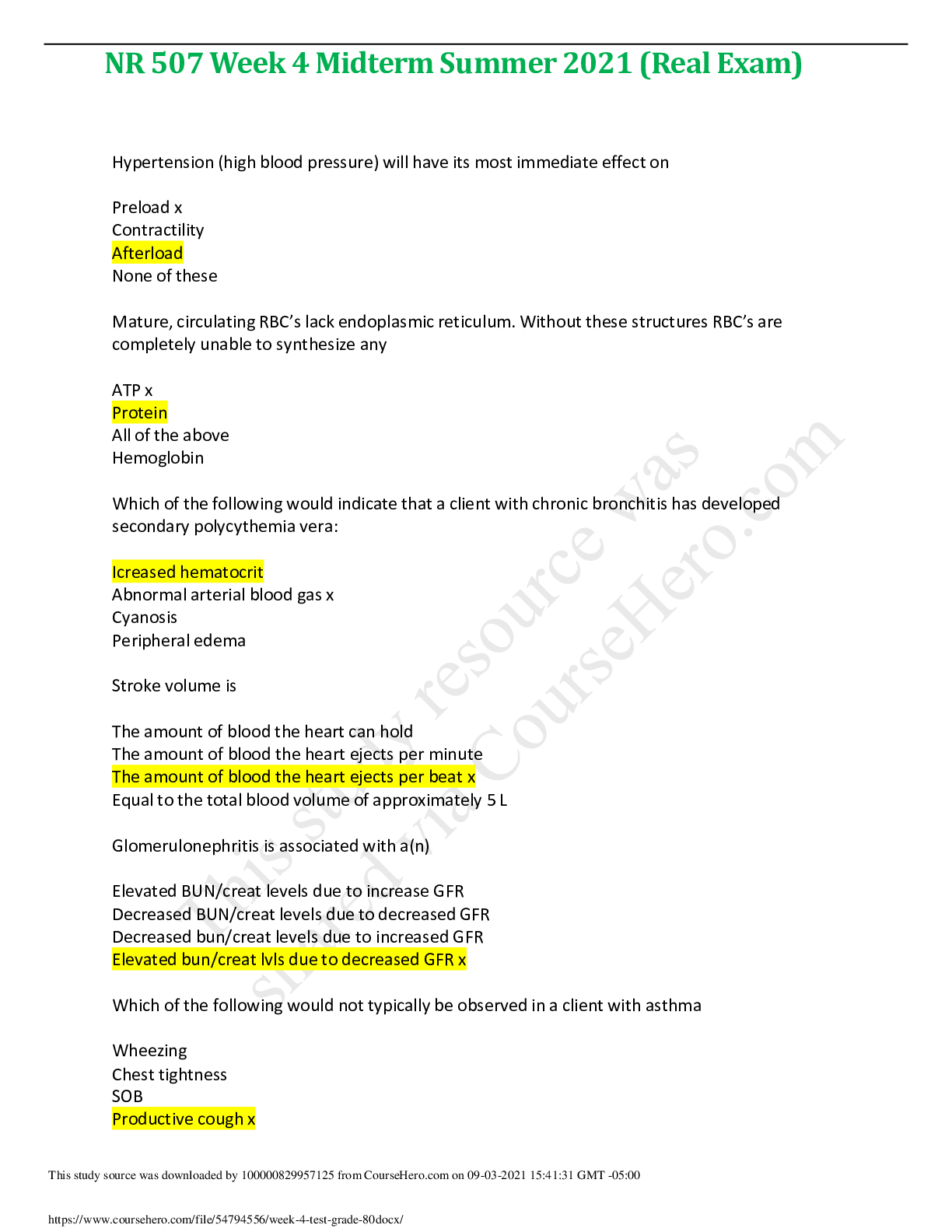


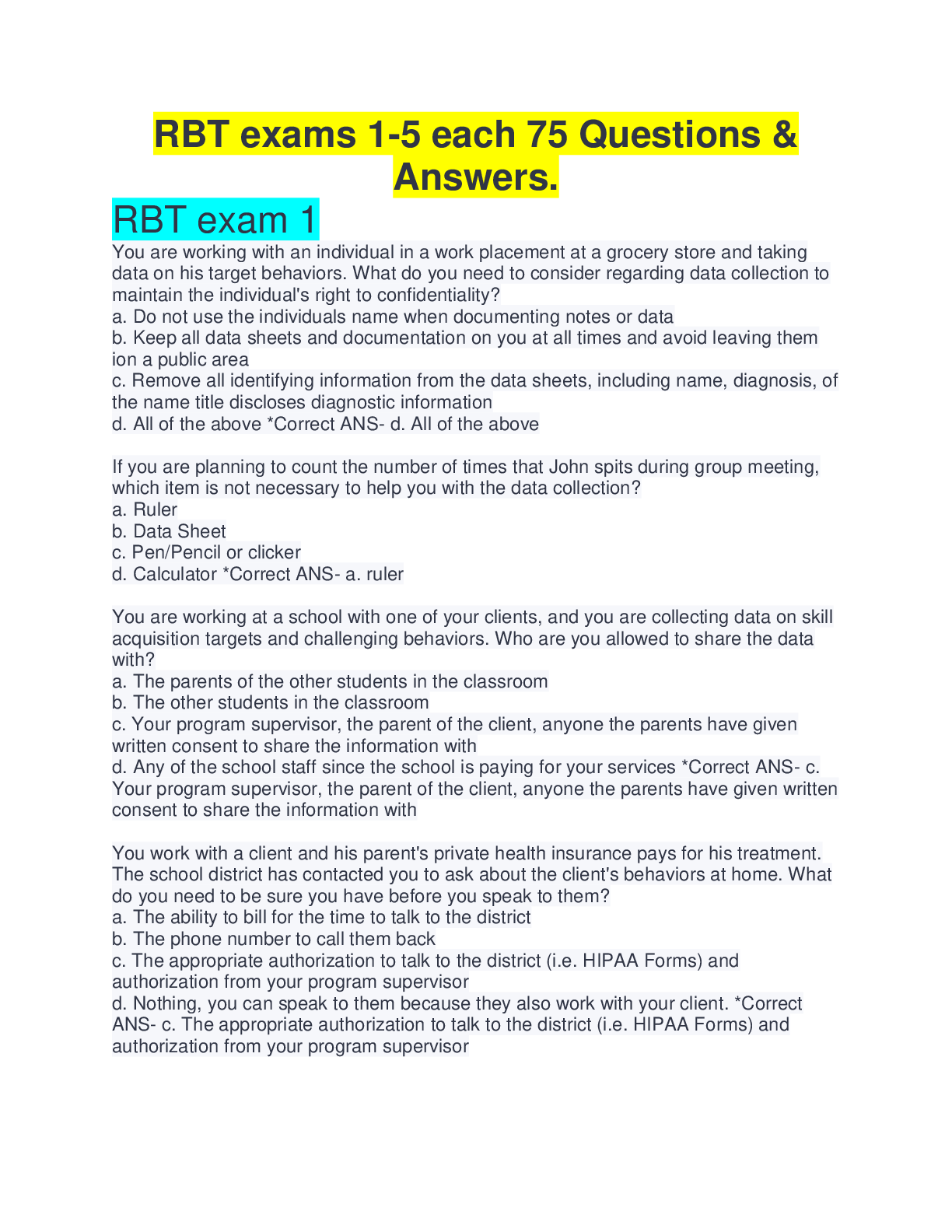

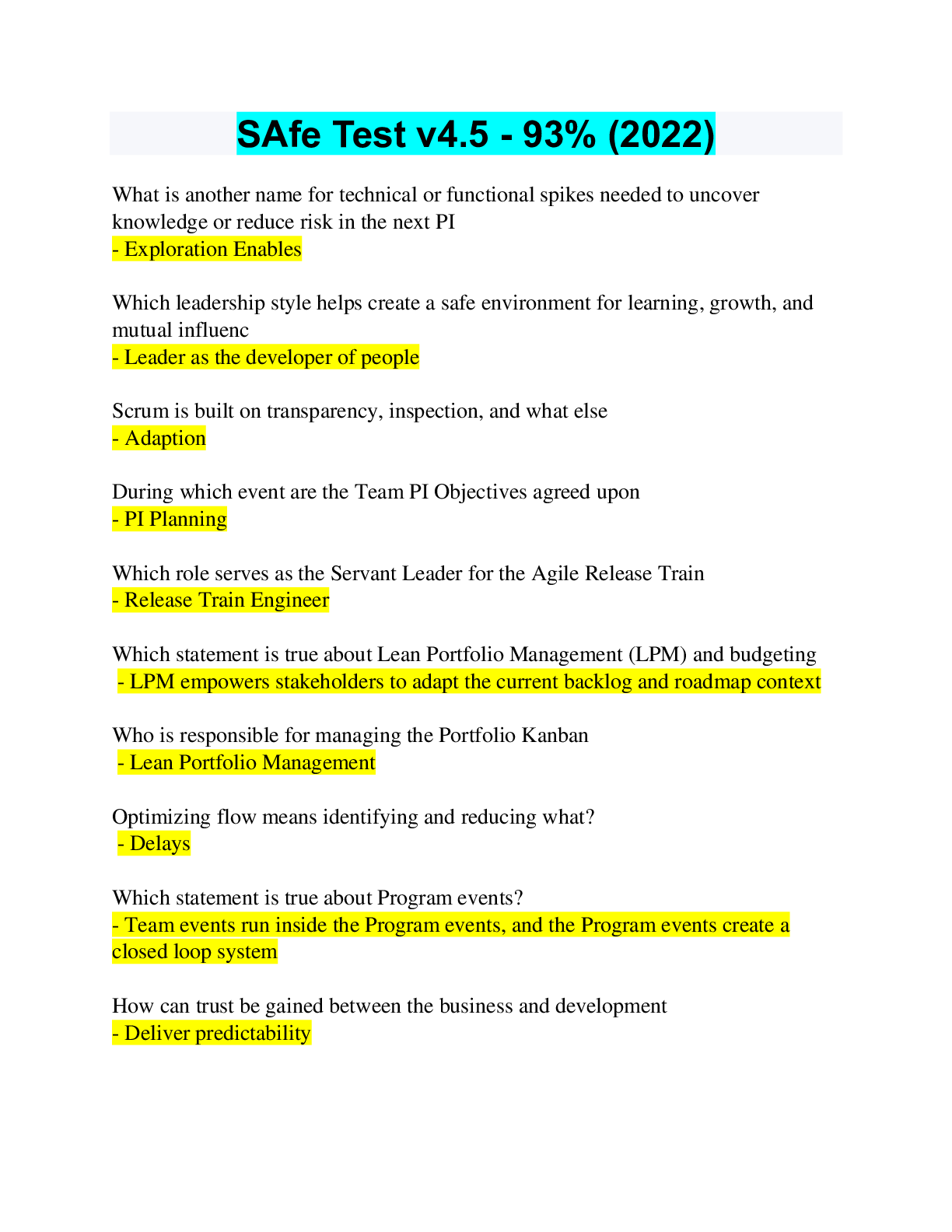
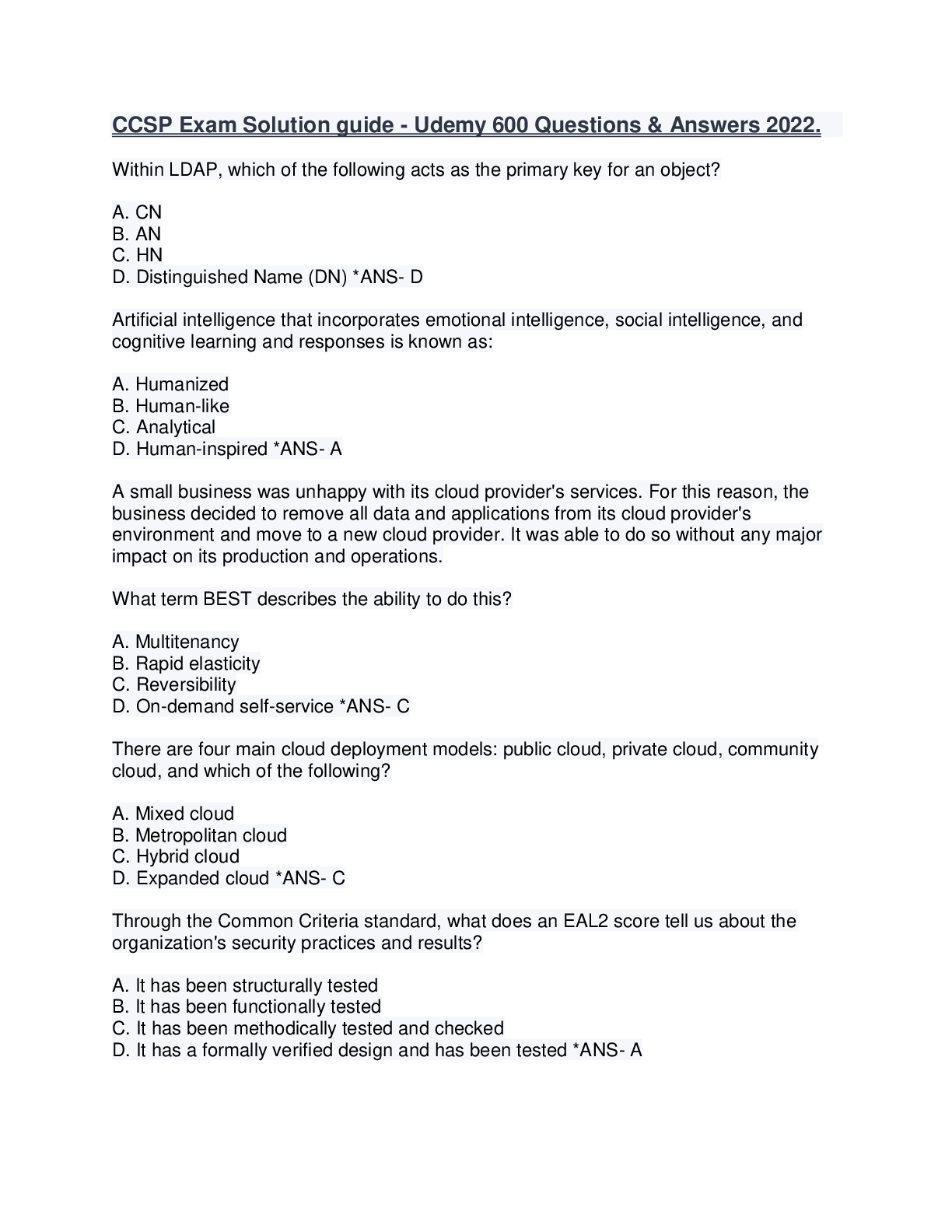
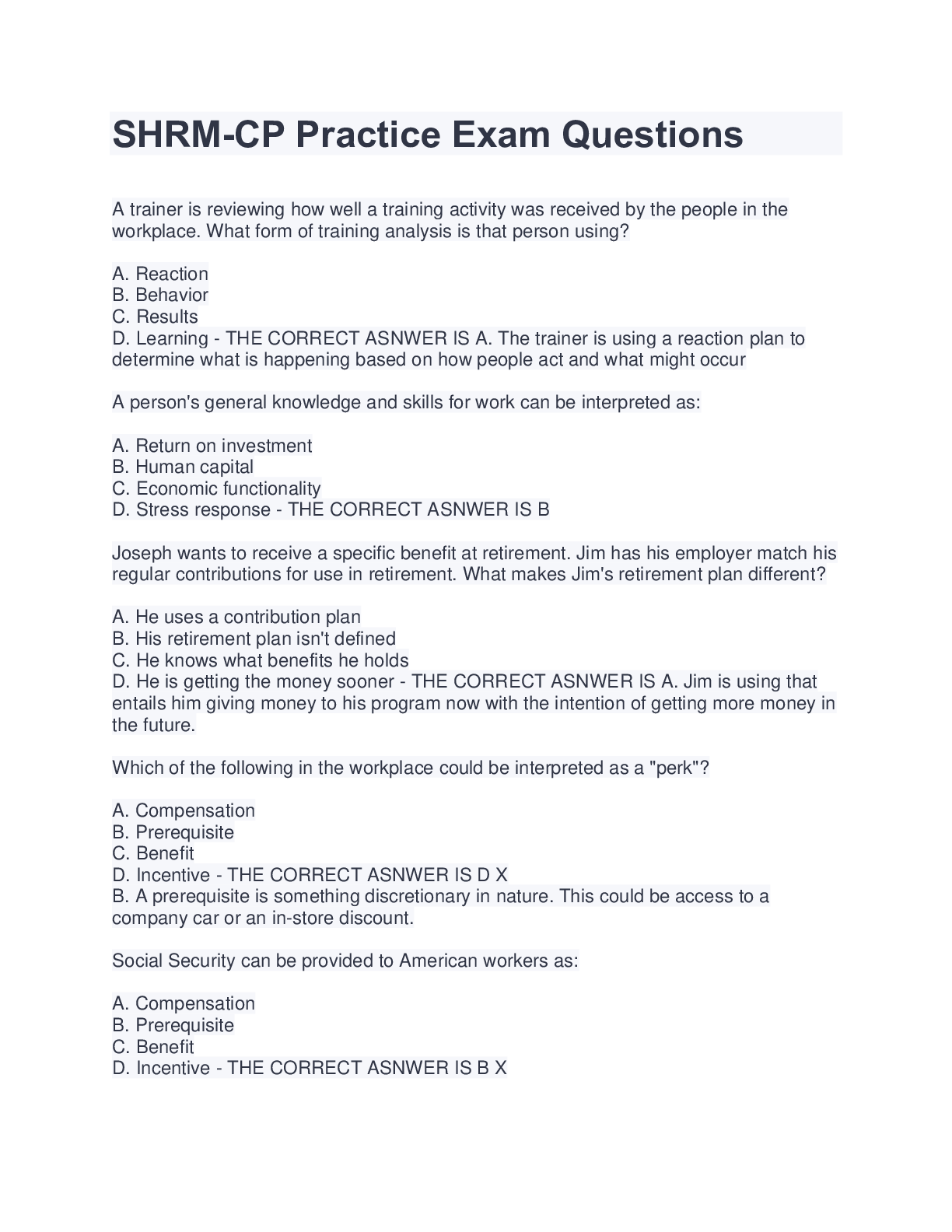

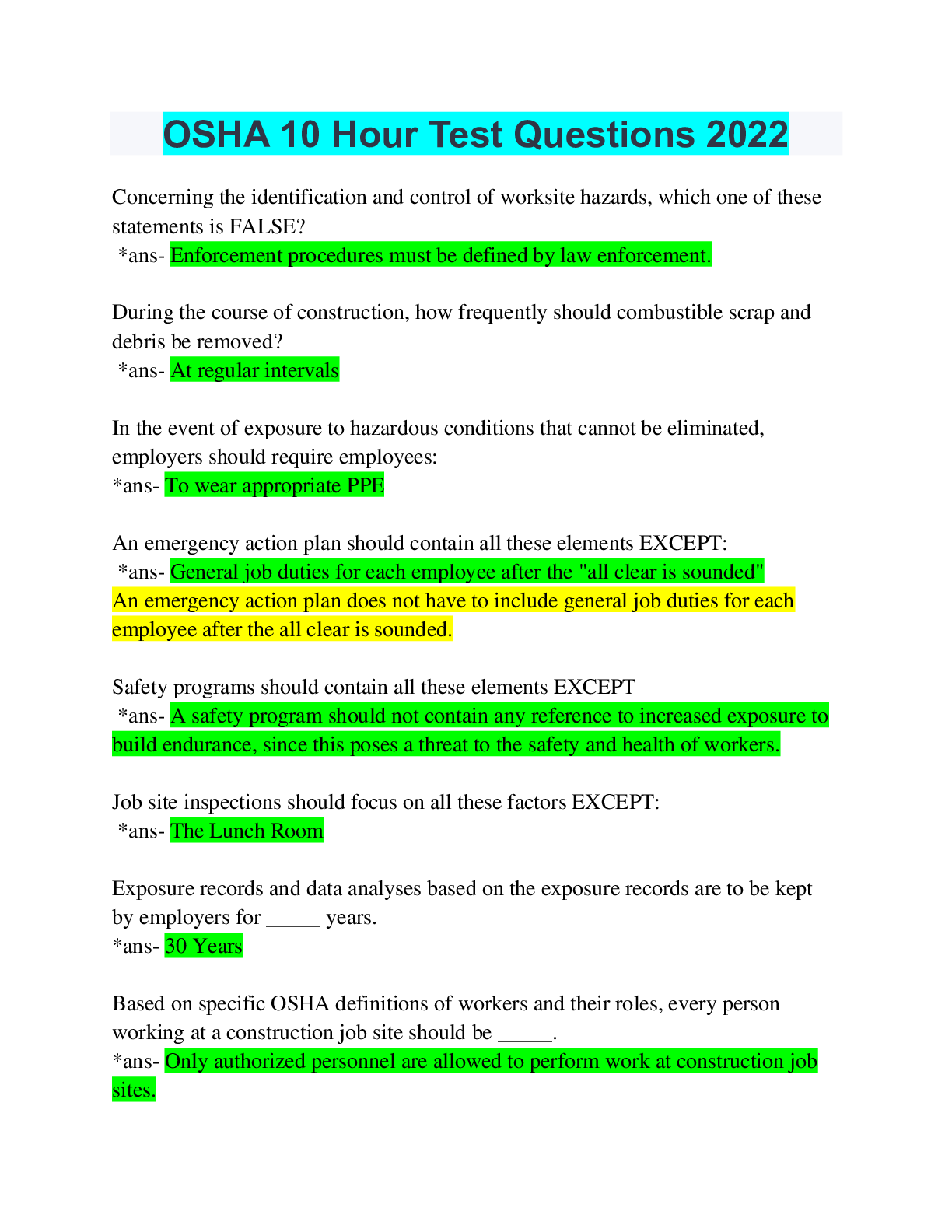
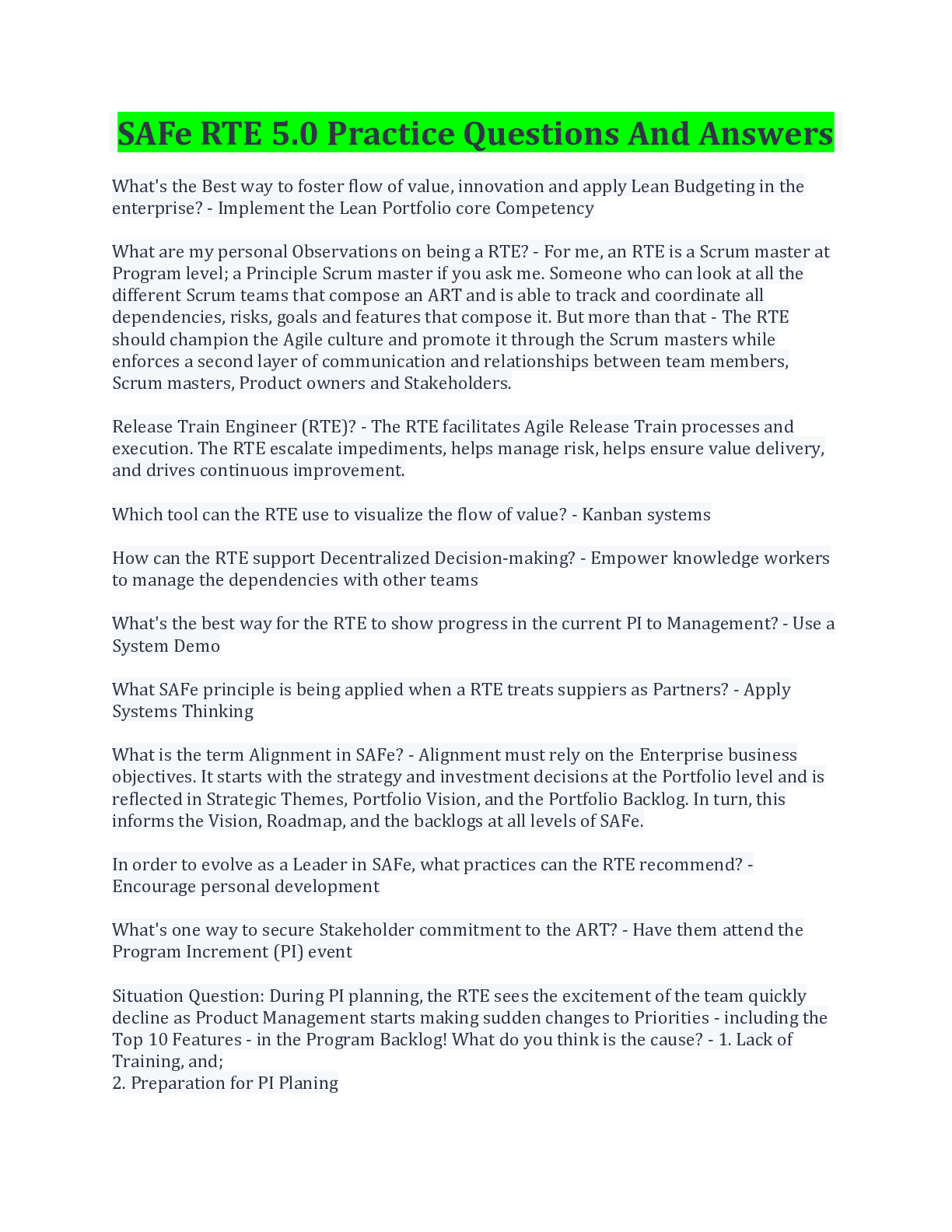

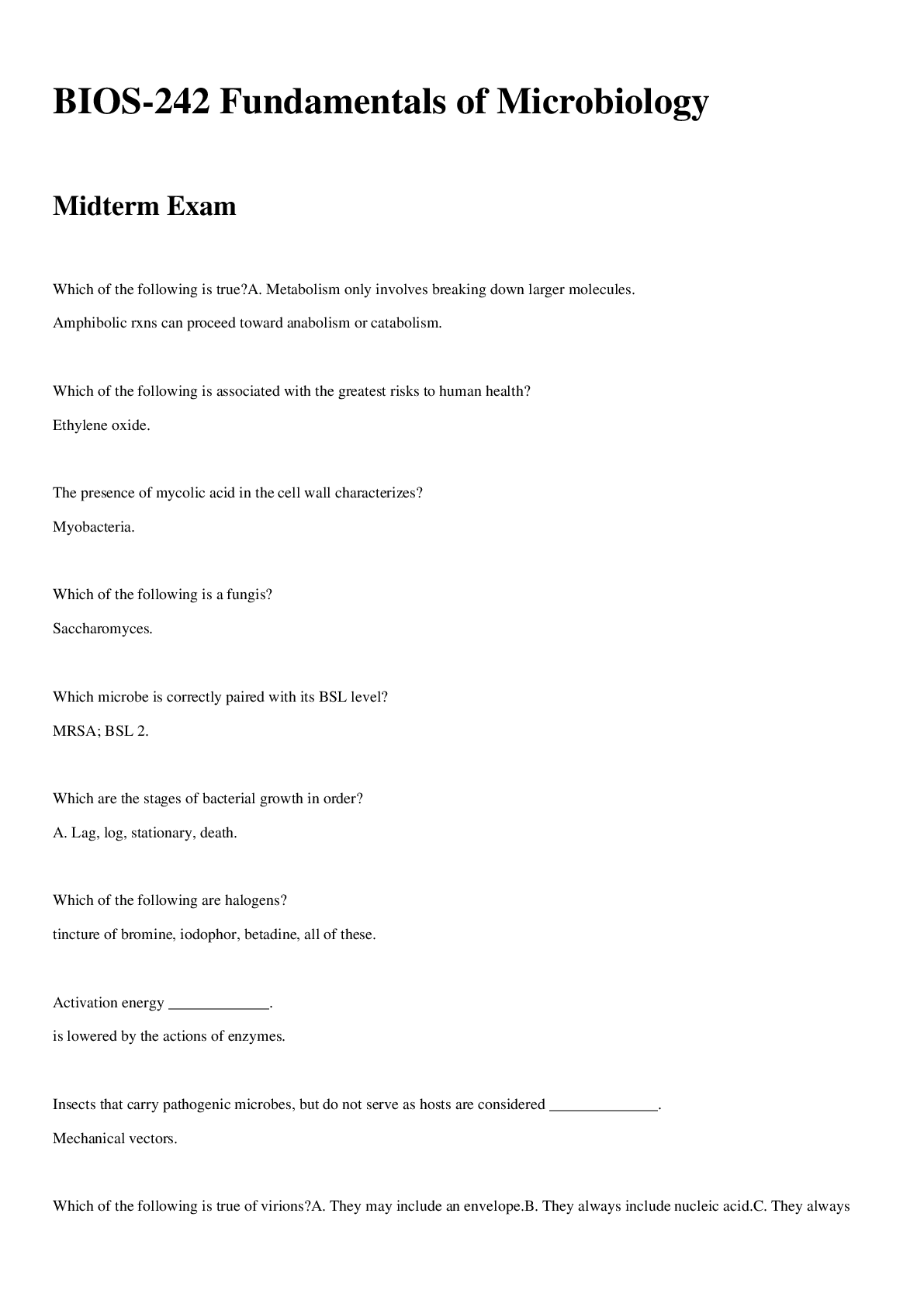
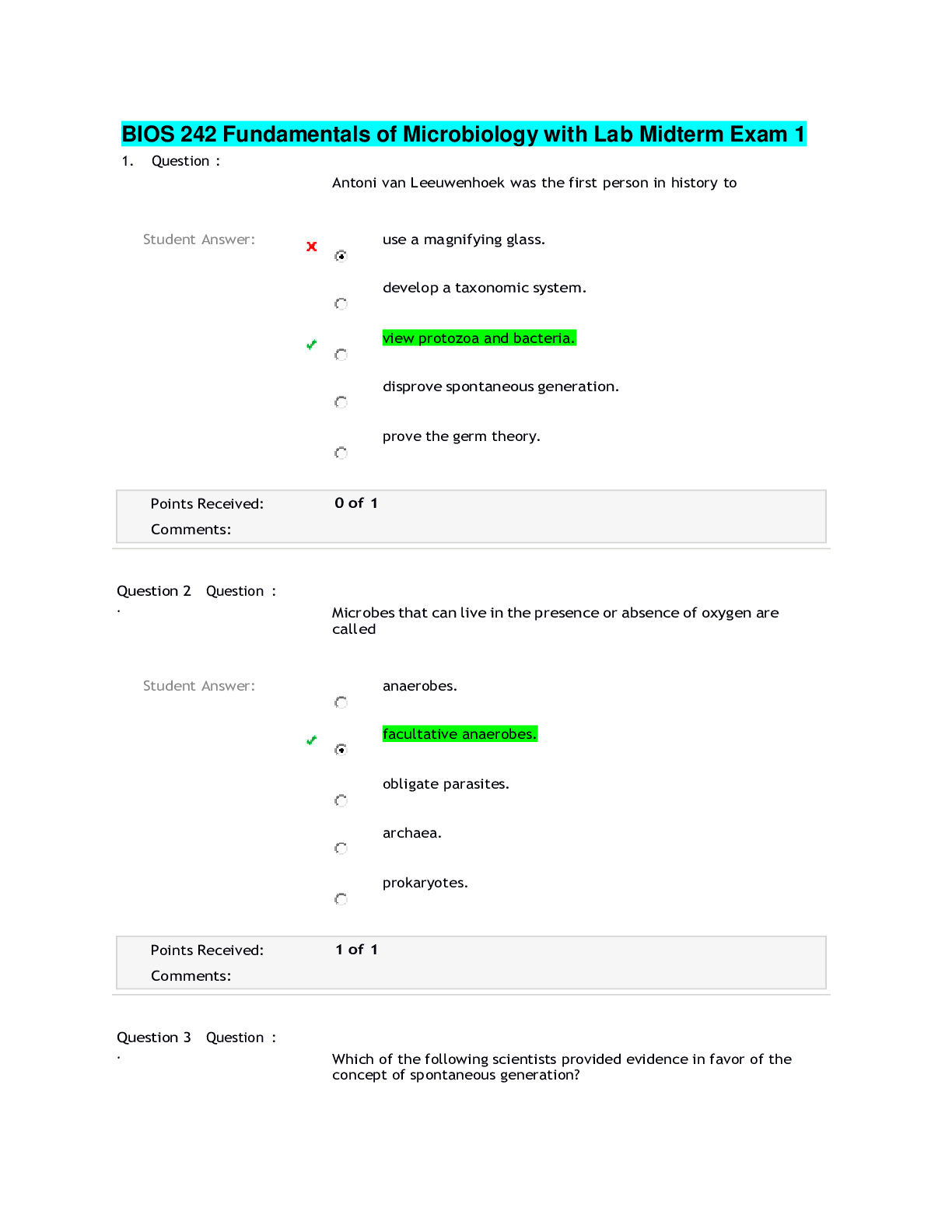
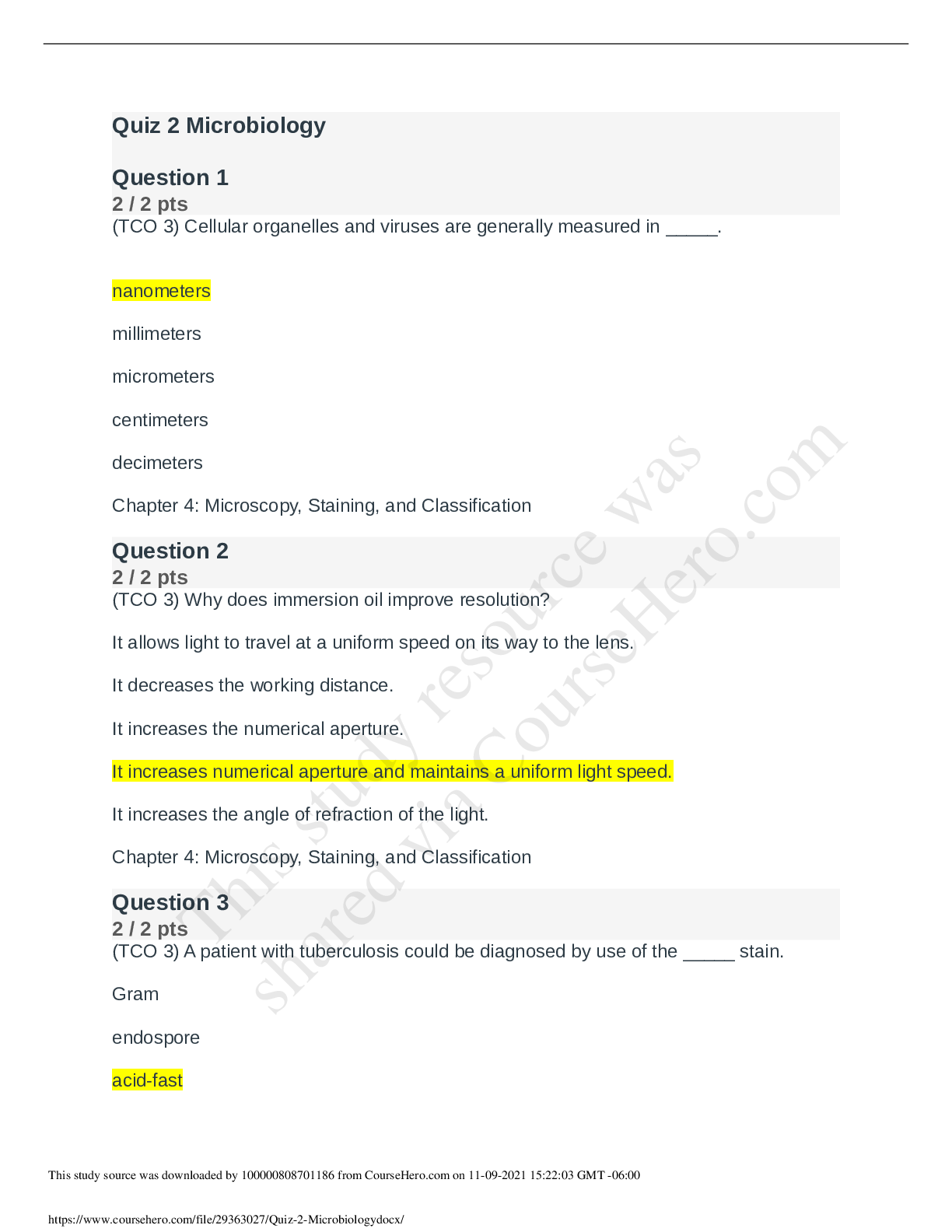
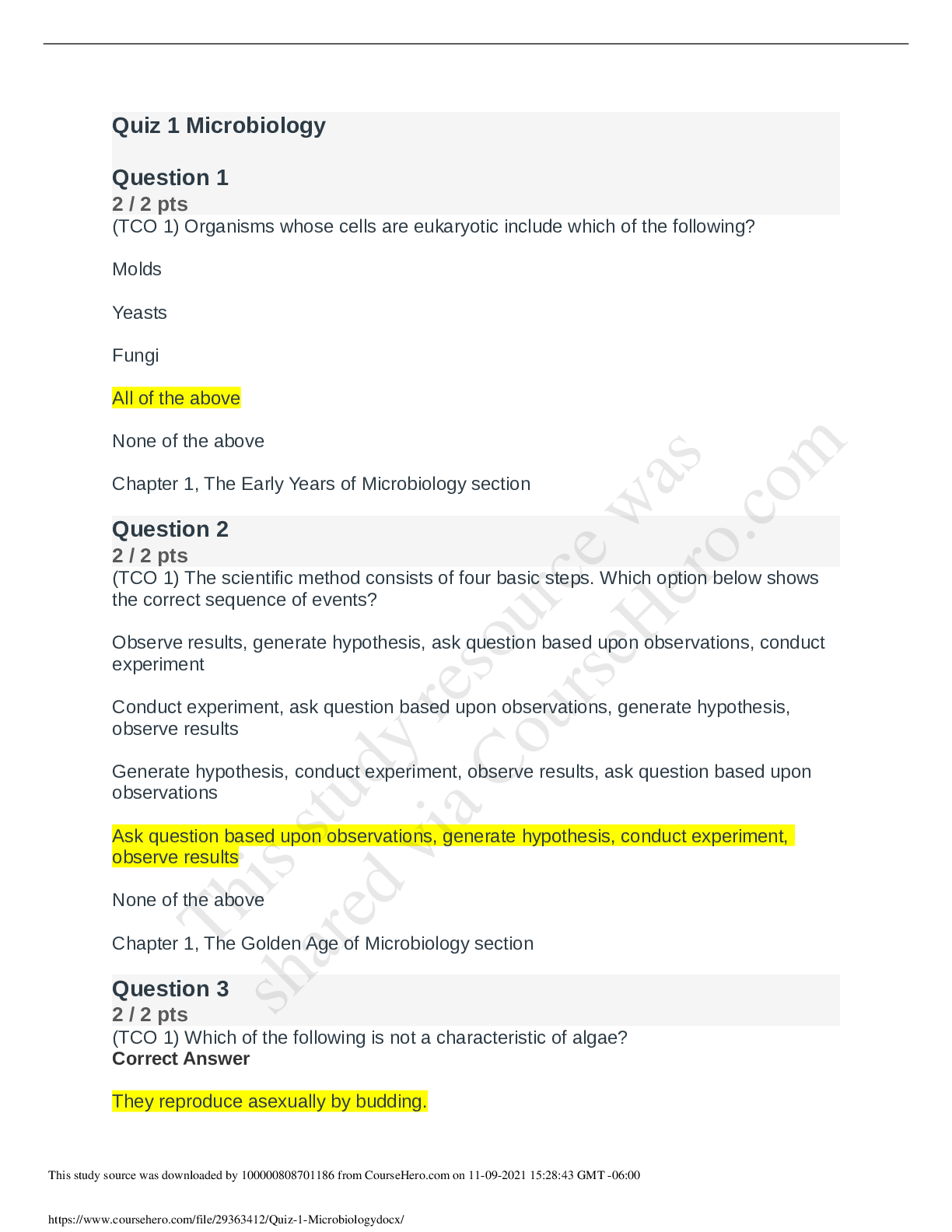
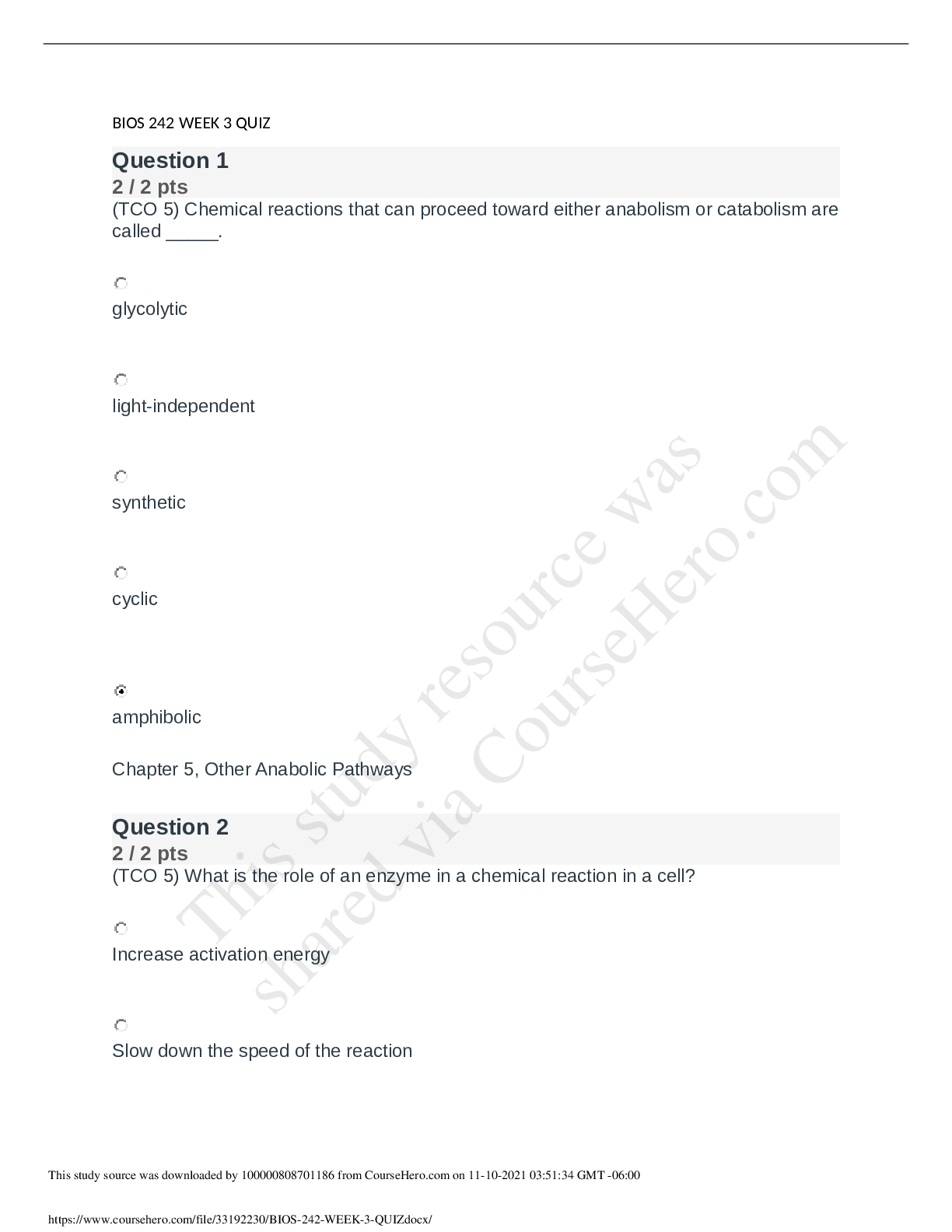
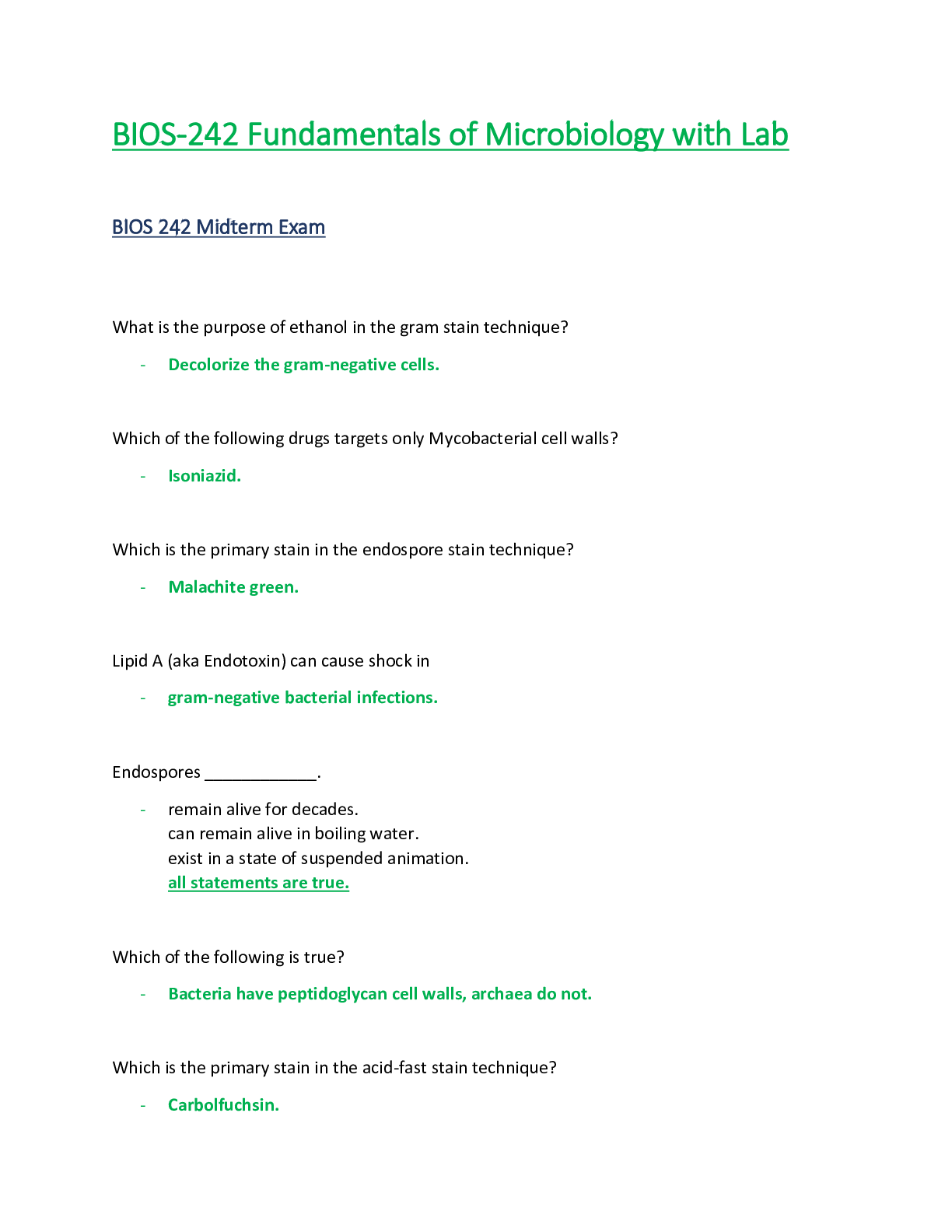


.png)
.png)
